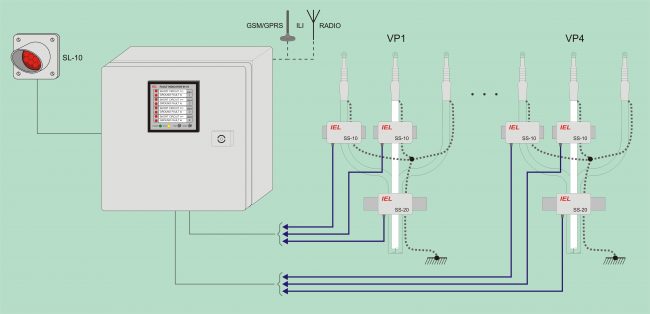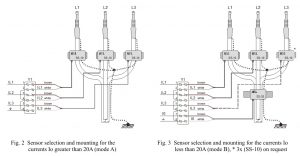SIK-10 Fault Indication System is used for detection and indication of ground fault and short circuit in grounded networks, i.e. in substations 10 (20) / 0,4 kV with or without remote control. The SIK-10 consists of a SS-xx Current Sensor, a Fault Indicator IK-10 and a Signal Lamp SL-10. Unconventional current sensors are used as fault detectors.
Depending on the magnitude of the ground fault current, there are two fault detection methods. If the ground fault current is greater than 20A, mode A (fig. 2) is used, i.e., one SS-10 Current Sensor is mounted on each of the three phase cables. When a higher sensitivity is required, i.e. for ground fault currents less than 20A, the mode B (fig. 3) is used, that is, the two SS-10 type sensors are placed on the two phase cables and the SS-20 type sensor includes all three phase cables.
[showhide type=”opis” more_text=”Show more” less_text=”Show less”]
In the event of a ground or short-circuit fault, the sensors and the fault indicator detect, indicate and register the fault before the line is switched off by the protection. The Fault Indicator IK-10 indicates the type of fault and fault location locally on the LED elements for the associated feeder. In addition to local fault indication on the IK-10, there is also an external signalling with the SL-10 Signal Lamp (on the outer wall of the substation) which is easily visible even from a greater distance. Parameterization of the device (defining the ground fault and short circuit current, reset mode and time, trip time of indicator, etc.) is performed easily using DIP switches. Depending on the complexity of medium voltage grid, IK-10 indicators can be used in substations without remote control while Remote Terminals DT-10S and SS-xx Current Sensors can be used in remote-controlled substations. The Fault Indication System can be upgraded with an IK-GSM / GPRS unit or a radio modem IK-RM40 for very economical remote monitor and control of the grid fault from the control center. The software in the center can be NETVIZ (IEL) or another standard SCADA system. For insulated grids, IK-20 Fault Indicators are used.
- ground fault (Io) and short circuit detection for each feeder (max. 4 feeders with one IK-10) in the grounded grid
- indication of the type of fault (Io or I>>) and the fault location (feeder number) on the LED display
- two types of sensors (SS-10 and SS-20) depending on the ground fault sensitivity
- simple on site parameterization with DIP switches
- own uninterruptible power supply
- small dimensions, savings in space, wiring and testing
- very economical remote monitoring of fault by adding GSM / GPRS module or radio modem IK-RM40
- a combination of SIK-10 Fault Indication System with GSM / GPRS communication and DT-10S Remote Terminals and SS-xx Current Sensors in remote control stations provide the ability to quickly detect a fault location, reconfigure the grid and increased network availability
[/showhide]



